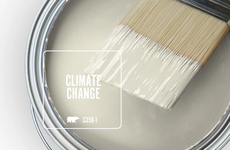
This White Paint is Engineered to Cool Surfaces Down
Elena Rahman — April 29, 2021 — Eco
References: purdue.edu & ecowatch
Engineers from Purdue University have created white paint that could revolutionize the way we use air conditioning systems. The cutting-edge paint reduces surface temperature by 18 degrees Fahrenheit without consuming any energy at all.
According to the engineers on the project, the paint works by repelling heat away from the surface it's painted on and absorbs a minimal amount of solar energy. The white paint can be used on the tops of buildings to cool the entire structure down and repel heat towards the atmosphere.
It is important to note that not only does the paint works by pushing heat waves away from its surface, it actually pushes the heat beyond the Earth's atmosphere and into deep space, where heat travels indefinitely at the speed of light. Thus, this technology could be a pivotal tool in the fight against climate change by cooling down the Earth's surface.
Image Credit: Purdue University
According to the engineers on the project, the paint works by repelling heat away from the surface it's painted on and absorbs a minimal amount of solar energy. The white paint can be used on the tops of buildings to cool the entire structure down and repel heat towards the atmosphere.
It is important to note that not only does the paint works by pushing heat waves away from its surface, it actually pushes the heat beyond the Earth's atmosphere and into deep space, where heat travels indefinitely at the speed of light. Thus, this technology could be a pivotal tool in the fight against climate change by cooling down the Earth's surface.
Image Credit: Purdue University
Trend Themes
1. Heat-repellent Paints - There is opportunity for this technology to be expanded to create a range of heat-repellent paints, both in color and in function.
2. Sustainable Cooling Solutions - This technology offers an opportunity for the development of more sustainable methods of climate control, especially in areas with high temperatures.
3. Passive Cooling Systems - The use of this paint could also potentially change the way that architects and builders approach building design, encouraging the incorporation of more passive cooling systems.
Industry Implications
1. Architecture - This technology presents an opportunity for architects to integrate the paint in the designs of homes and buildings that require temperature control.
2. Paint Manufacturing - Paint manufacturers can develop a line of heat-repellent paints using this technology, catering to the growing demand for sustainable and energy-efficient products.
3. Construction - This technology could impact the construction industry by influencing the type of materials used in building design and encouraging the integration of more sustainable and energy-efficient cooling solutions.
3.4
Score
Popularity
Activity
Freshness















